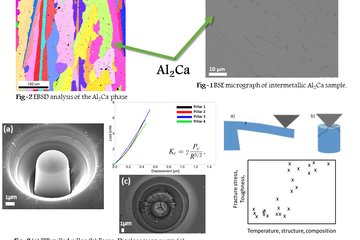All genres
2401.
Thesis - PhD
Mechanical properties in metallic glasses and their deformation mechanisms. Dissertation, RWTH Aachen, Aachen, Germany (2016)
2402.
Thesis - PhD
Elementary deformation processes during low temperature and high stress creep of Ni-base single crystal superalloys. Dissertation, Ruhr-University Bochum, Bochum, Germany (2016)
2403.
Thesis - PhD
Experimental-theoretical study of the interplay between deformation mechanisms and secondary phases in metastable β titanium alloys. Dissertation, RWTH Aachen, Aachen, Germany (2016)
2404.
Thesis - PhD
On the strain hardening mechanisms of a high-Mn lightweight steel. Dissertation, RWTH Aachen, Aachen, Germany (2016)
2405.
Thesis - PhD
Martensitic Stainless Steel: Evolution of Austenite during Low Temperature Annealing and Design of Press Hardening Alloys. Dissertation, RWTH Aachen, Aachen, Germany (2016)
2406.
Thesis - PhD
Transformation Phenomena during Quenching and Partitioning Heat Treatment. Dissertation, RWTH Aachen, Aachen, Germany (2016)
2407.
Thesis - PhD
Microstructure design via site-specific control of recrystallization and nano-precipitation. Dissertation, RWTH Aachen, Aachen, Germany (2016)
2408.
Thesis - PhD
Investigation of intermetallic layer formation in dependence of process parameters during the thermal joining of aluminium with steel. Dissertation, RWTH Aachen, Aachen, Germany (2016)
2409.
Thesis - PhD
Effects of strain amplitude, cycle number and orientation on low cycle fatigue microstructures in austenitic stainless steel and aluminum. Dissertation, RWTH Aachen, Aachen, Germany (2015)
2410.
Thesis - PhD
Stiff and damage-tolerant metallic glasses. Dissertation, RWTH Aachen, Aachen, Germany (2015)
2411.
Thesis - PhD
Nanolaminate TRIP-TWIP martensite matrix steels: Design and Characterization. Dissertation, RWTH Aachen, Aachen, Germany (2015)
2412.
Thesis - PhD
Micromechanically guided design of graded ultrafine-grained dual-phase steel. Dissertation, Ruhr-Universität Bochum, Bochum, Germany (2015)
2413.
Thesis - PhD
Designing ductile martensitic steel microstructures via localised austenite formation controlled by tailored chemical gradients. Dissertation, RWTH Aachen University, Aachen, Germany (2015)
2414.
Thesis - PhD
Segregation driven phase transformation in medium Mn steel. Dissertation, RWTH Aachen University, Aachen, Germany (2015)
2415.
Thesis - PhD
High Resolution Crystal Plasticity Simulations. Dissertation, Aachen Institute for Advanced Study in Computational Engineering Science (AICES), RWTH Aachen University, Aachen, Germany (2015)
2416.
Thesis - PhD
On the nano-scale characterization of kesterite thin-films. Dissertation, RWTH Aachen University, Aachen, Germany (2015)
2417.
Thesis - PhD
Thermal stability of AlN/CrN superlattice hard coatings. Dissertation, RWTH Aachen University, Aachen, Germany (2015)
2418.
Thesis - PhD
Micromechanical modeling of martensitic phase transformation in steels based on non-local crystal plasticity. Dissertation, Ruhr-Universität Bochum, Bochum, Germany (2015)
2419.
Thesis - PhD
Nucleation of Mo-rich Laves phase particles in 12% Cr steels. Dissertation, Ruhr-Universität Bochum, Bochum, Germany (2014)
2420.
Thesis - PhD
Dynamic correlations and confinement effects in glass forming hard sphere systems. Dissertation, RWTH Aachen, Aachen, Germany (2014)










